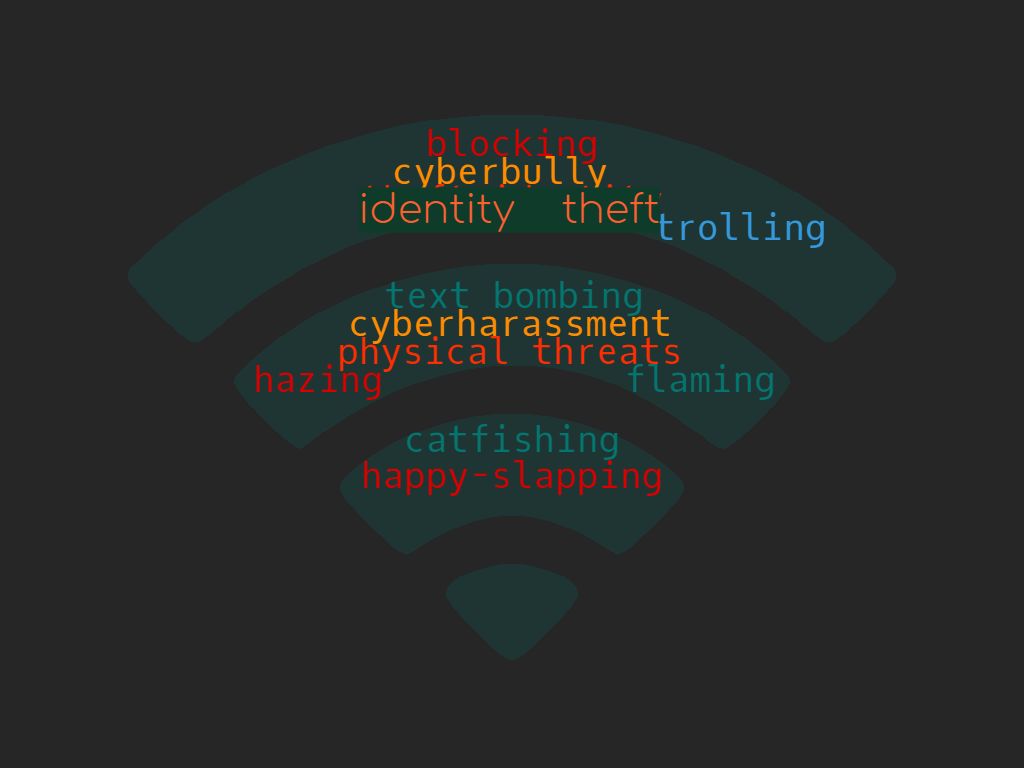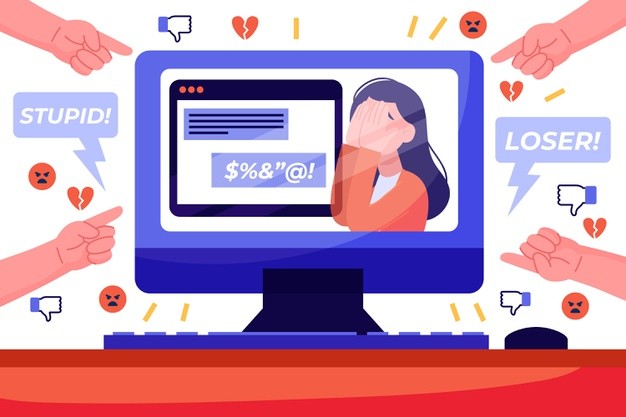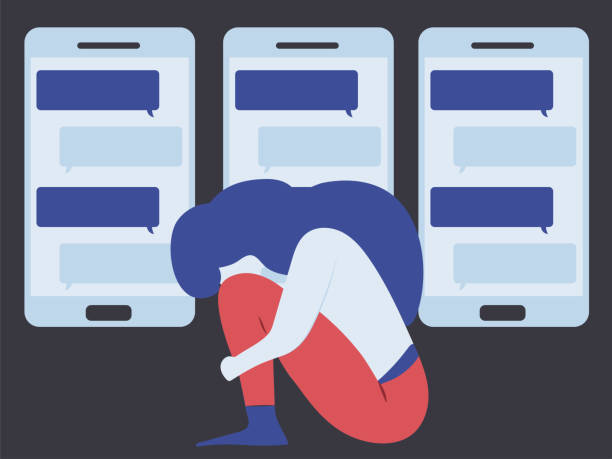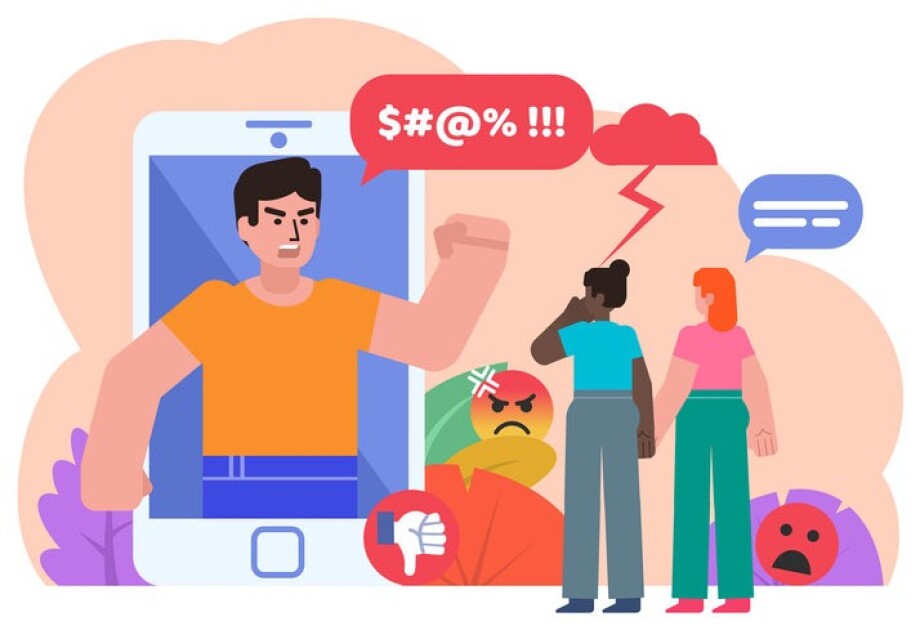This worksheet is designed to help your teenagers learn more about cyberbullying and how to stop it. It will suit High Intermediate level students who are 15 years old and older.
Completing these tasks they’ll find out more about how to navigate social networks safely, how to protect yourself from cyberbullies or how not to be a cyberbully themselves. At the same time, they’ll learn to express their opinion in English, discuss important social English and train their listening comprehension by watching a video.
Task 1. Lead-in
Look at the picture. Answer the questions:

— What does this image represent?
— What feelings does it evoke in you?
— Have you been in a situation where you received some negative insulting messages or comments on the Internet?
— Did you insult or troll other people on the Internet?
— Have you heard of “Cyberbullying”? What is this?
Task 2. Vocabulary work
Read the definition of cyberbullying.
According to Wikipedia, Cyberbullying or cyberharassment is a form of bullying or harassment using electronic means. Cyberbullying and cyberharassment are also known as online bullying. It has become increasingly common, especially among teenagers, as the digital sphere has expanded and technology has advanced.
What words can you associate with cyberbullying?
Task 3. Word associations
Now, look at the word cloud. Does it have any of your ideas?
Try to explain the meaning of the words that you can see in the picture. Use the dictionary if needed.
Which of the concepts have you come across in your cyber-life?

Keys:
Blocking — stopping emails, text messages, phone calls, etc. from being received
Cyberbully — someone who uses the internet to harm or frighten another person, especially by sending them unpleasant messages
Identity theft — the crime of using someone’s personal information in order to pretend to be them and to get money or goods in their name
Trolling — the act of leaving an insulting message on the internet in order to annoy someone
Text bombing someone means you are sending 1000-10000 text messages to the same person in the same day, and it can go from being simply annoying to cruel
Cyber Harassment is the use of Information and Communications Technology (ICT) to harass, control, manipulate or habitually disparage a child, adult, business or group without a direct or implied threat of physical harm.
A physical threat is a potential cause of an incident that may result in loss or physical damage to the computer systems.
Hazing — the activity of playing tricks on someone, especially a new person in a fraternity or sorority (= a social organization for university students)
Flaming — the act of sending an angry or insulting email
Catfishing — the practice of pretending on social media to be someone different, in order to trick or attract another person
Happy slapping — the activity of attacking someone and filming the attack, especially with a mobile phone
Task 4. Pre-watching
Answer the questions:
- How many hours a day do you spend on your smartphone?
- Do you try to control your screen time? If so, how do you do that?
- Do you think smartphones help us to be more productive? In what way?
- Why should we be careful using our smartphones and the Internet?
Task 5. Watching the video
Watch the video.
Name the tips mentioned in the video that will help you to stop bullying.
Keys:
- Block the haters
- Stay offline for some time
- Ask for support from the communities who are fighting against cyberbullying.
Task 6. After-watching
Answer the questions.
- Is cyberbullying a totally new concept? Why or why not?
- Why is cyberbullying so popular nowadays?
- What do you need to remember if you are dealing with bullying online?
- Where can you find support if you are cyberbullied?>
- What should you do to protect yourself from cyberbullying?
- How can you help others to stay protected?
Keys:
- Bullying has existed since the ages of caves, it has only become “cyber — bullying” now because a lot of people are on the Internet and use their technologies to bully others.
- Because almost everyone is on social media nowadays.
- Remember that you can always block cyberbullies, and that you aren’t alone.
- There are quite a few communities on the Internet that share their experiences and advice on how to protect yourself from bullies (check Reddit, YouTube, Instagram* and other social media).
- Block the people who send you hateful messages or harass you, tell an adult about this unpleasant experience, deactivate some of your accounts for some time if needed, seek for the support from other users.
- Support them, tell them what they can do in this case (see answer 5) and never be a cyberbully yourself.
Task 7. Discussion

Read the situations, say how you would act and explain your choice.
- In a school online group chat someone sends an embarrassing photo of your classmate. What do you do?
- When chatting you send a rude message to your friend thinking it was a joke. Your friend gets upset with you. What’s your reaction?
- Your classmate tells you that she’s afraid of darkness and sleeps with her lights on. You find it funny and really want to share this info online. Will you do that? Why or why not?
Task 8. Speaking
Complete the sentences with your own ideas:
- Cyberbullying is a bad type of behaviour because…
- A cyberbully is a person who…
- People who suffer from cyberbullying are…
- To protect yourself from cyberbullies you need to…
- Cyberbullying can make people feel
Task 9. Speaking

Look at some things you should or should not do on the Internet to stop cyberbullying.
| DO | DON’T |
Put the statements in the right column. Add your ideas to each column.
1. when your friend posts a joke about another person on the Internet, you need to like and promote it.
2. share your and your friends’ contact details if a blogger you follow asks about it.
3. report hateful or abusive behaviour you come across on social media.
4. tell your friends and the younger kids about the rules of navigating social media.
5. blame yourself if people on the Internet start sending you threats and hateful messages.
5. if you face cyberharassment, tell an adult you trust about what’s going on
Task 10. Test out your knowledge
To find out how much you’ve learned about cyberbullying in this lesson take this quiz and discuss the results with your peers.
Homework: Create a poster about how to stop cyberbullying and share it with the class.






 Вероника Аветисян
Вероника Аветисян 
 Маргарита Аветисян
Маргарита Аветисян 


